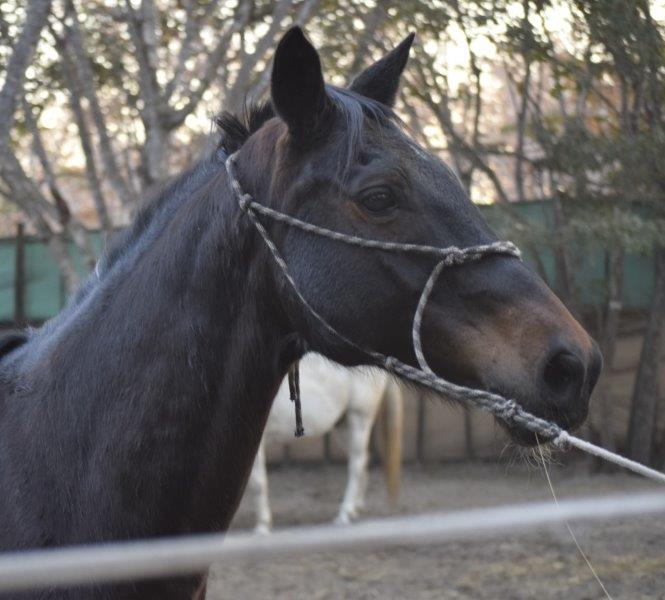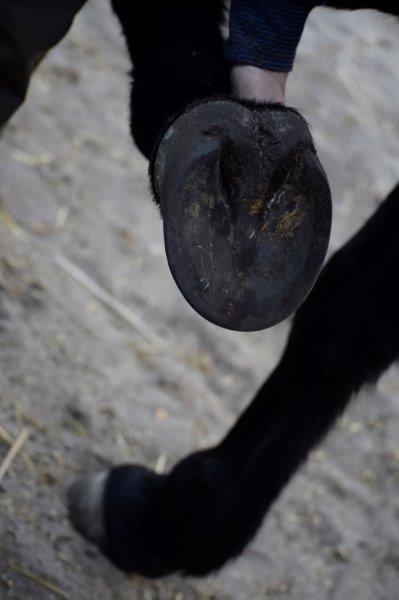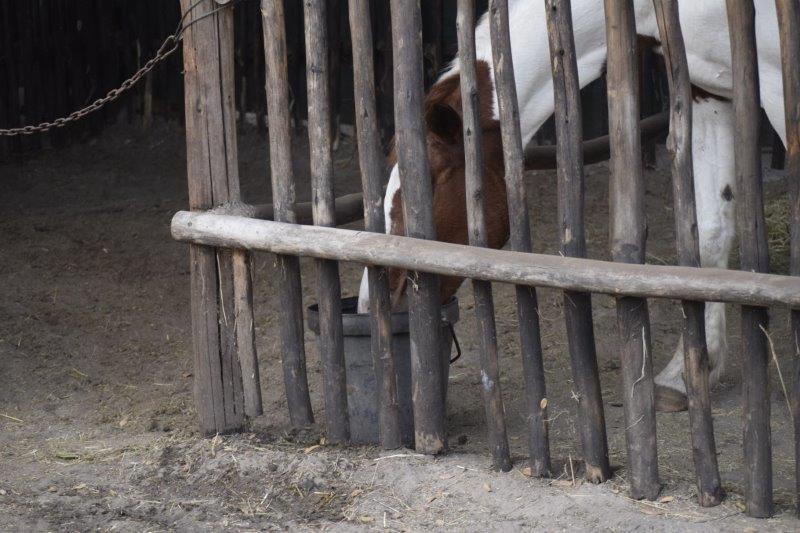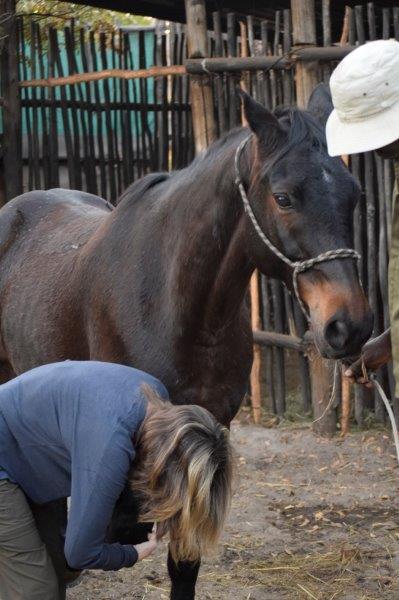On visiting a riding safari establishment next to Hwange National Park in Zimbabwe, I immediately wondered how horses could exist so close to the national park and not get eaten by lions – which led to the next question: what is it like to be a horse in Africa?

There are several breeds and crossbreeds of horses that exist in Zimbabwe, with the Boerperd being the more common one used for these safaris. The Boerperd is a modern breed of horse, not dissimilar to our Australian Stock Horse. They are descendants of the original Cape horses that were in southern Africa centuries ago. Unfortunately, the numbers of Cape horses dwindled with the Boer wars in the late 19th century due to their destruction by man, and the efforts to replenish the numbers in the 20th century has resulted in the establishment of the newer breed.
The Boerperd is a robust, tough and versatile horse, able to cope with the extreme temperature variations seen in southern Africa, from 50°C in the hot summers to sub-zero in winter. These horses are a very agile breed and show the ideal traits of stamina and surefootedness, which, when coupled with their intelligence, calmness, and willingness to work, makes them good candidates for riding in and around the national parks.
They are not overly big horses, and this has led to some owners breeding them with larger breeds, such as Thoroughbreds, Warmbloods and Irish Sport horses, to increase the size and strength of the Boerperd – thereby allowing them to carry larger/heavier riders. Currently, the heaviest rider they will take is 95kg. Boerperds have good hardy feet and receive regular hoof care by their grooms; they do not need to be shod as they cope very well working on the African terrain without them.

“The Boerperd is
a robust, tough and
versatile horse.”

SAFE AS HOUSES
Housing the horses for a safari requires a double perimeter. The outer perimeter is an electrified fence to prevent wildlife, especially lions, from moving into the outer walls of the enclosure, or “boma” as it is referred to here. The inner perimeter or outer wall of the boma is a high canvas wall that totally prevents the lions from seeing the horses, and the horses from seeing the lions and becoming stressed, creating a visual and physical barrier. Lions are motivated to hunt by movement, and if they can’t see their prey move, they are less likely to attempt to breach the perimeter.
The horses are housed during the night in either a smaller stable composed of defoliated tree branches or trunks, or in a larger yard within the canvas wall where several horses are housed together. There are staff housed in these enclosures to protect the horses should there be a problem. If the horses become agitated or stressed, the staff are alerted and can assess the environment, but this situation seldom occurs. During the day, the horses are tethered on long ropes outside the wire fences and allowed free access to the grass but are guarded constantly by at least two grooms.
The yards and fencing are portable so they can be erected where required when on a safari, as the horses must always be protected. It takes three hours to set up an enclosure that is safe for the horses and causes minimal damage to the natural environment, as all structures and rubbish is fully removed when the safari moves on.
In this operation, the safari horses generally start their working life around five years of age and may work until they are 18, however, retirement age from riding will depend on the individual horse. A few mares are bred each year for replacement stock.


Safari horses generally work a week on and a week off, with a few days of schooling before they are back on safari. Safaris are generally for a week and horses may work 6-7 hours a day covering 40-50km at walk, trot, and canter. They have short breaks in between working and have a long break over lunch where they are untacked, so their backs are given a good rest. Water comes from the natural pans (water storage areas) in the bush or pumped (manmade) pans. In the hot dry weather, water will be supplied to horses at designated meeting points.


The rainy season in southern Africa is from December to March. The horses in the riding safari I visited are given this time off as it is unpleasant to ride in the rains with insects and biting flies flourishing and causing a lot of problems for horses and people. Managing a herd of horses when the nearest veterinarian is four hours away is also a challenge. Horse husbandry in these scenarios must be good to enable the horses to remain healthy and free of disease as there are few second chances if the owners get it wrong. Emphasis is placed on keeping the horses healthy rather than treating a problem when it occurs.
PESKY PARASITES
Worming is dictated by regular faecal egg counts taken every three months and submitted to a laboratory, with drenching occurring when egg counts start to climb. This reduces the incidence of worm resistance to modern day worming compounds by ensuring that selection for parasites resistant to the chemicals does not occur as it does in Australia (with constant drenching, only resistant worms survive and without competition from other “less resistant” worms, these resistant worms build up in numbers until they become the dominant worm).
Ticks can also be a problem with horses as they can carry small protozoan organisms that then infect the horse. These protozoa cause piroplasmosis, referred locally as “Biliary”, a disease that can be fatal. Piroplasmosis is a severe anaemia, caused by the protozoa destroying red blood cells. Horses become weak, jaundiced, and lose weight and this disease can be very difficult to treat. The ticks cannot be just pulled off the horse once they have attached themselves as this can leave the head of the tick in the horse and cause necrosis to the area. Ticks are particularly prevalent during the rainy season, so to manage this correctly horses are dipped regularly in a pesticide to protect them during the wet season.

“Ticks can also be a
problem with horses.”
Teeth are checked annually and maintained as required by a vet. There are no specialised equine dentists in Zimbabwe, so the vets are required to take on this role also.
Annual vaccinations are given to prevent African Horse Sickness (AHS), Tetanus, Equine Encephalosis Virus (EEV) and Rabies. AHS is a virus transmitted by biting midges (culicoides spp) and carries a very high mortality rate (up to 90%). Horses when infected develop high fevers and can show swelling around the face, eyes, lips, and neck, or show trouble breathing and can develop a frothy nasal discharge. Once symptoms appear, signs can rapidly deteriorate, with death occurring in as little as a few days. Thankfully, we do not have this virus in Australia.
The second of the viruses transmitted by culicoides spp and managed by vaccination is Equine Encephalosis Virus and this can cause clinical symptoms like AHS but is a lot milder and is only occasionally fatal.
Rabies is another virus that affects the nervous system and invariably causes death. Contact with saliva from an infected animal leads to an infection and once infected, these rabid horses can transmit the disease to humans. There is no cure for rabies once the disease is established but vaccination provides good protection.

LESS COLIC, FEWER LEG INJURIES
In Australia, our husbandry practices of high grain diets and restricting feeding to 1-2 times a day have led to a higher incidence of colic than seen here. The incidence of colic is very low, primarily because the horses have access to roughage in their diets most of the day. The owners have medications on hand and are very proficient at treating their horses under the guidance of a veterinarian available only on the end of a telephone. Surgical colic is rare fortunately, as any surgery would require a horse to be transported 12 hours to the capital Harare where the only equipped equine theatre exists – otherwise it’s a paddock knockdown in the bush.

There are not many large animal vets in Zimbabwe and even fewer equine vets, but most of these vets have had a lot of experience in field surgeries, particularly with wildlife requiring field anesthesia for injuries incurred because of humans (snares and traps). Veterinarians in Zimbabwe are not allowed to treat or interfere with wild animals that are aged, injured or sick from natural causes, they can only become involved if the injury or sickness is attributable to humans.
One of the more common veterinary problems these safari horses suffer is damage to the eyes. Penetrating eye wounds are not uncommon due to the hazardous nature of riding through the bush. Fine twigs and thorns are prevalent, and it is impossible to protect the eyes completely. A lot of riding is done across open grassland but even this can cause irritation to the eye with winds and long grasses allowing fine particles and debris to fly up into the eye. This can cause ulceration of the cornea and if not treated appropriately and quickly can cause permanent damage to the eye. In extreme cases, the eye can be damaged so badly that the horse loses the sight in that eye.
Leg injuries are also less common than in Australia, most likely because they are not housed in yards or paddocks with wire fences. It is common for horses to kick out over fences and strip their hind legs in Australia but there is little to kick over in these enclosures. The most common cause of injury is from small wounds riding through the bush and these are managed with topical cleaning and medication. Antibiotics are on hand if the wounds are deep or become infected.
Other injuries such as abscesses, lameness and respiratory ailments are dealt with by the owners through necessity, as they have few other options when things go amiss.
An interesting facet of managing safari horses is introducing them to wildlife, as most horses will not have been exposed to wildlife before they come to the safari area. I have been told that the scariest animals for horses to cope with initially are the ostrich and giraffe, but the elephant, lion and buffalo are the most dangerous animals for horses outside their enclosures.

ACCLIMATISED TO WILDLIFE
Bringing in a new horse to the herd entails a couple of weeks of acclimatisation. The horse stays in the boma during the day (with a friend) getting used to the sounds and smells, and learning where it gets its feed. Depending on the horse this might take three or four days or up to 10. After this, the horse is given access to the outer boma area and electric fence where it can now see everything around it. From here it progresses to going out in-hand with the other horses and then to being ridden. Once well acclimatised, the horse can go on safari.
When on safari, horses are not intentionally put into dangerous situations, so they are generally relaxed around wildlife once they have acclimatised. This enables the riders to witness nature at its best, sighting so many different species whilst on horseback in a relaxed and comfortable way. The key to maximising this experience, however, is to ride with an experienced professional safari guide that not only knows the area inside out, but also knows and trusts their horses. The horse’s safety and the safety of the riders and handlers is all dependent on the skill and knowledge of the safari guide, both on the ride and on the ground.
Special thanks for this article must be given to James and Janine Varden, at Ride Zimbabwe. Without their input and vast experience they were happy to share, I would not have been able to complete this story. Should anyone have queries regarding doing a horse-riding safari in Africa, contact riding@vardensafaris.com for full details. EQ
YOU MIGHT ALSO LIKE TO READ BY DR MAXINE BRAIN:
Splint Bone Fractures – Equestrian Life, June 2023
When Horses Choke – Equestrian Life, June 2023
The Challenge of Treating HPSD – Equestrian Life, May 2023
From the Horse’s Mouth: Salivary Glands – Equestrian Life, February 2023
Cardiac Murmurs – Equestrian Life, February 2023
Matters of the Heart – Equestrian Life, January 2023
Umbilical Concerns in Foals – Equestrian Life, December 2022
Retained Foetal Membranes – Equestrian Life, October 2022
Preparing for Laminitis – Equestrian Life, September 2022
Working Together for Best Outcomes – Equestrian Life, August 2022
What Constitutes an Emergency – Equestrian Life, July 2022
Peri-Tarsal Cellulitis Calls for Quick Action – Equestrian Life, June 2022
Sinusitis: Not To Be Sneezed At – Equestrian Life, May 2022
Japanese Encephalitis: No Cause For Alarm – Equestrian Life, April 2022
Hernia Learning Curve – Equestrian Life, March 2022
Osteochondromas: Benign But Irritating – Equestrian Life, February 2022
Don’t Forget the Water – Equestrian Life, January 2022
Understanding Anaesthesia – Equestrian Life, December 2021
A Quick Guide to Castration – Equestrian Life, November 2021
Caring for Mammary Glands – Equestrian Life, October 2021
Sepsis In Foals – Equestrian Life, September 2021
Understanding Tendon Sheath Inflammation – Equestrian Life, August 2021
The Mystery of Equine Shivers – Equestrian Life, July 2021
Heads up for the Big Chill – Equestrian Life, June 2021
The Ridden Horse Pain Ethogram – Equestrian Life, May 2021
The Benefits of Genetic Testing – Equestrian Life, April 2021
Heavy Metal Toxicities – Equestrian Life, March 2021
Euthanasia, the Toughest Decision – Equestrian Life, February 2021
How to Beat Heat Stress – Equestrian Life, January 2021
Medicinal Cannabis for Horses – Equestrian Life, December 2020
Foal Diarrhoea Part 2: Infectious Diarrhoea – Equestrian Life, November 2020
Foal Diarrhoea (Don’t Panic!) – Equestrian Life, October 2020
Urticaria Calls For Detective Work – Equestrian Life, September 2020
Winter’s Scourge, The Foot Abscess – Equestrian Life, August 2020
Core Strengthening & Balance Exercises – Equestrian Life, July 2020
The Principles of Rehabilitation – Equestrian Life, June 2020
When is Old, Too Old? – Equestrian Life, May 2020

